Determining Back Pack Usage Among College Students by Gender
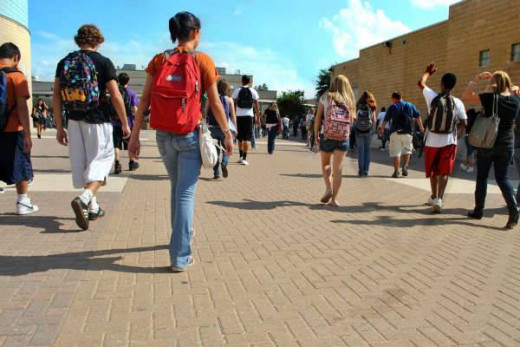
Back packs and gender
The volume of work in a college class can be enormous. In addition to more work, the number of books, tools and supplies needed to participate in class has also increased. With this increase students have resorted to an elementary school classic to carry these supplies, the back pack. With the advent of the backpack, ferrying around... these items has become a lot easier. The technology of the backpack has evolved from the canvas knapsack to miniature luggage on wheels. Although this technology has allowed more items to be carried, the distance student’s walk between classes and buildings hasn’t changed much. What would determine whether students use stairs or elevators if they were carrying a backpack? Would there be a difference in gender of the usage and travel between floors with or without a backpack?
Do feel that kids backpacks are getting too heavy for daily school use?
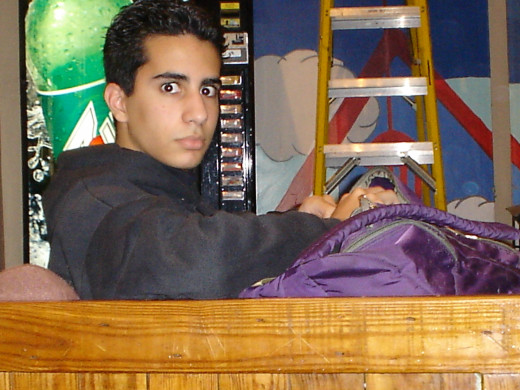
Access for stairs vs. elevators may be a factor
Recent research suggests that the structure, location and access for stairs vs. elevators may be a factor. According to Nicoll (2006) “spatial qualities that optimize the convenience and legibility of stairs may have the most influence on stair use in buildings” (p.346). In her study she wanted to know whether workplaces make it accessible for physical activity to take place in the form of climbing stairs. She found that people will use stairs if it’s more convenient than waiting for elevators. She also noted that people will use stairs if their social group uses them.
In another study Kwak, Kremers, van Baak and Brug (2007) found that prompts in the form of posters could increase stair use. The intervention sites where the study was conducted were in an office building with 150 white collar employees and in a paper factory with 800 mainly blue collar employees. The study was conducted in the Netherlands. In both buildings posters were placed near the elevator and stairwell entrance. The elevator posters had 4 slogans: “Free workout?”, “Walking Buffet?”, “A Break?”, and “Desert?” In front of the stairwells were posters with two slogans: “One step closer to your energy balance” and “On your way to the balance between food intake and physical activity”. All posters ended with the slogan: “The stairs. A good Idea!”. Their results indicated that “overall prompts had a short effect in increasing stair use of approximately 5%.” (p.180).
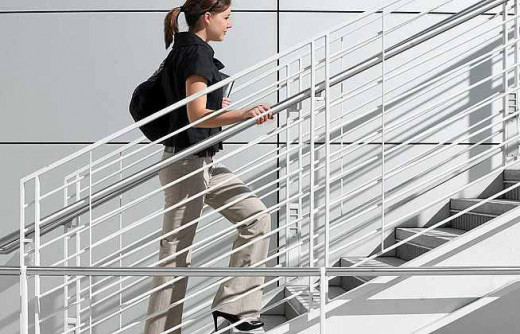
Investigating the use of prompts for stair use
In another study investigating the use of prompts for stair use, Eves & Webb (2006) looked at worksite campaigns in the United Kingdom. One of the findings in their study indicates that behavior may play a significant role in choosing between escalator and stair use. “When the lift is not available, individual travelers may chose the stairs, not for health reasons, but simply because it is a faster option.” (p.6). Their study also discovered that music and artwork were more effective in increasing stair use than signs alone.
Modeling behavior has also been measured to determine whether people may use stairs more often. Adams, Hovell, Irvin, Sallis, Coleman and Liles (2006) investigated whether “concurrent competing or synergistic social and structural features of the environment determine lifestyles.” (p.102). They set up their study at the San Diego International Airport, using staircases and escalators. Seven male and two female models were used during the study. Their ages were between 22 and 31 except for one man who was 65 years old. They would dress differently and were in different physical condition ranging from normal to obese. These models would walk up stairs, walk another 100 feet, then turn around and descend on the staircase. They would wait for travelers to get near the stairs, and then walk up and down them. In another phase of the experiment, two models would walk with each other talking loudly. When they got close to the stairs they would say to each other “let’s take the stairs this time” loudly in order for other travelers to hear them. The result indicated that stair use increased 9.9% in the presence of the models and verbal prompts. Stair use among men increased 15.8% in the presence of male models. Stair use increased among females 8.9% in the presence of female models.
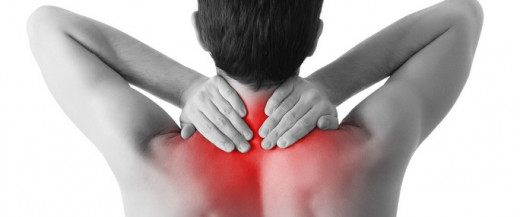
Back and neck pain caused by wearing back packs
Another factor in modes of travel for backpack wearers was the back and neck pain caused by wearing the accessory. Navuluri & Navuluri (2006) initiated a study in two junior high schools Hobbs, New Mexico. They wanted to assess backpack use and neck and back pain in seventh and eighth graders. A survey questionnaire was distributed to 27 boys and 32 girls. In the survey were questions about how painful it is to carry a backpack. The scale used was the Borg CR10 scale, with a number 1 ranked as the least painful to 10 ranked the most. Data was collected on the weight of the backpacks, and 34% of girls and 37% of boys had back packs that weighed > 15% of their body weight. “A positive correlation between backpack weight and pain is consistent with our common experience”. (Navuluri & Navuluri, 2006). More female students reported back and neck pain than male students. The conclusion in the study was that children may carry heavy backpacks because they feel that they can’t voice their concerns. Their status as minors makes them feel that they have to do what’s expected of them. If school administrators, nurses and parents begin to listen to their children they may reduce the injuries associated with back pack use.

Participants and Materials
One hundred and sixty students were observed at the campus of the University of Texas-Arlington. The participants included eighty four males and seventy six females. No monetary reward was given for participation. Since the participant’s behavior was documented using naturalistic observation, they were not aware of their participation in the study.
Design and Procedure
The teams were assembled during lab and given the task to locate buildings with elevators. The instructions given to the teams were to observe students using naturalistic observation. We were tasked with documenting by gender who used the elevator and whether or not they had a backpack. After data was collected, the teams checked the inter-rater reliability of their observations. Tables were set up to collate all the data from each team in class. Megan Uhelski took the observations from each team and created additional tables from the data. The data was divided by gender and backpack usage. From that data the X² was calculated and Ha (alternative hypothesis) and Ho (null hypothesis) was determined.
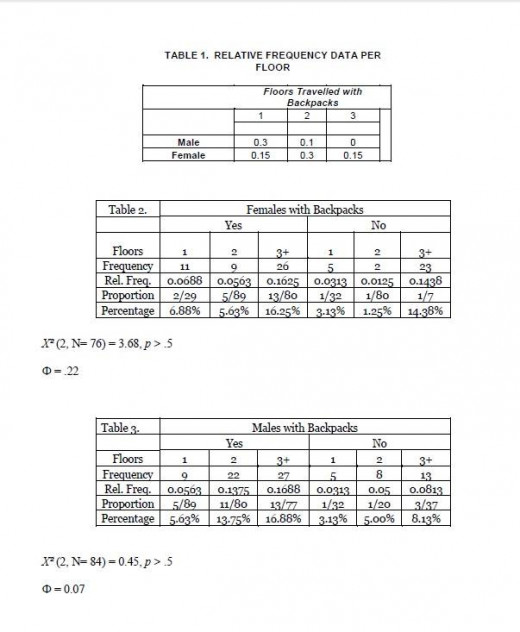
Results table 1 through 3
The data in table 1 was team data that was compiled with the relative frequency graphed in figure1. In table 2 the Ho was that there would be no difference between the number of floors travelled and whether females carried or didn’t carry backpacks. Ha would be to reject the Ho, indicating there was a difference. There was a non-significant difference between females who carried or didn’t carry backpacks and the number of floors travelled, X² (2, N= 76) = 3.68, p > .5. In table 3 the Ho was that there would be no significance between the number of floors travelled and whether males carried or didn’t carry backpacks. Ha would be to reject the Ho, indicating there was a difference. There was a non-significant difference between males who carried or didn’t carry backpacks and the number of floors travelled, X² (2, N= 84) = 0.45, p > .5.
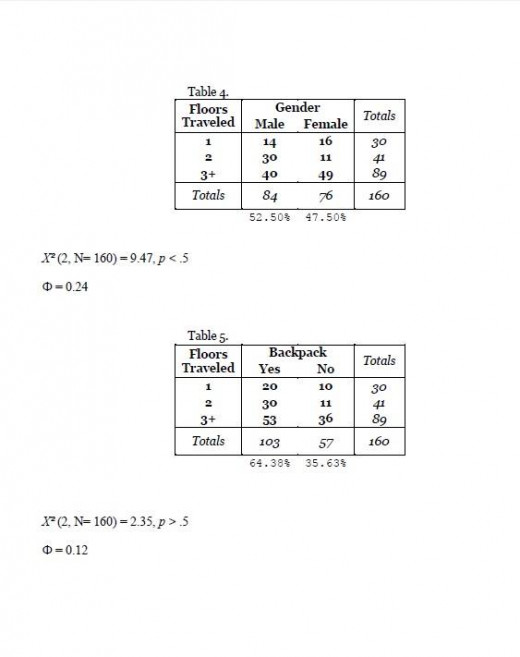
Results table 4 and 5
In table 4 the Ho would be that there was no difference in the number of floors travelled by gender. The Ha would be to reject Ho, indicating that there was a significant difference. There was a significant difference between floors travelled and gender, X² (2, N= 160) = 9.47, p < .5. This difference represents a slightly less than medium effect (V = 0.24). Gender did determine the number of floors travelled, with males travelling more floors in an elevator. In table 5 the Ho stated that there would be no difference between floors travelled and whether the participants did or didn’t have backpacks. The Ha would be to reject the Ho, indicating a difference. There was a non-significant difference between the number of floors travelled and whether or not participants had backpacks, X² (2, N= 160) = 2.35, p > .5.

Discussion
The results indicate that there was no significant difference in the number floors travelled and gender with or without back packs. The only data that showed significance was in table 4, where males travelled more floors than females. Back pack usage was not a factor in the number of floors travelled. The backpack data didn’t vary much by gender either. None of the studies cited in this report indicated that the load that one carries would determine mode of travel. The theory proposed was that backpack use would be a factor in the number of floors travelled inside of a building using an elevator. However, the only significant factor involved in floors travelled was gender.
The research conducted monitored back pack usage and elevator travel. Future studies should also include the number of flights of stairs travelled and whether or not these participants have backpacks. Another study could measure the BMI of study participants to determine whether body weight is a factor in stair or elevator use. BMI index may be the reason that more males than females travelled more floors in an elevator.
© 2008 Augustine A. Zavala
References
Adams, A. Marc, M. F. Hovell, V.I., J.F. Sallis, K.J. Coleman, S.Liles. (2006) Promoting stair
use by modeling: An experimental application of the behavioral ecological model. The
Science of Health Promotion (21) 101-109.
Eves, Frank F., Oliver J. Webb. (2006) Worksite interventions to increase stair climbing;
reasons for caution. Preventative Medicine (43) 4-7.
Kwak, L., S.P.J. Kremers, M.A. van Baak, J. Brug. (2007) A poster based intervention to
promote stair use in blue and white collar worksites. Preventative Medicine (45) 177-181.
Navuluri, Neelima& R.B. Navuluri. (2006) Study on the relationship between backpack
use back and neck pain among adolescents. Nursing and Health Sciences (8) 208-215.
Nicoll, Gayle. (2006) Spatial measures associated with stair use. The Science of Health
Promotion (21) 346-352.








